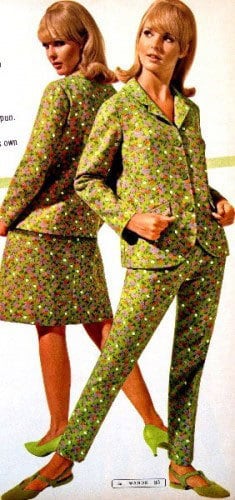Pantsuit Power: A Revolution Worn on Legs in the 1960s

The 1960s – a decade that pulsated with change, rocked against societal norms, and redefined the meaning of freedom. And amidst the swirling tides of this cultural revolution, a sartorial storm emerged: the pant suit. No longer relegated to the realm of practicality, the pant suit transformed into a fashion statement, a symbol of female empowerment, and a bold declaration of independence. So, dear fashion enthusiast, prepare to delve into the fascinating world of 1960s pant suits, where fabric became armor, trousers embraced femininity, and every tailored stitch whispered a story of liberation.
From Practical Beginnings to Runway Rebellion:
While trousers for women had existed for centuries, often associated with utilitarian needs like riding or wartime workwear, the 1960s saw their evolution into a fashion force. Women like Coco Chanel and Marlene Dietrich had planted the seeds, daring to wear pants in public and challenging conventions. But it was in the 1960s that the movement truly blossomed. Designers like Yves Saint Laurent, Pierre Cardin, and André Courrèges championed the pant suit, crafting sleek, sophisticated silhouettes that redefined femininity. Fitted jackets with nipped waists and cropped trousers hugged the curves, embracing a sensual yet powerful aesthetic. Gone were the baggy, utilitarian cuts of the past; these were suits designed to flatter, to move with confidence, and to make a statement.
A Palette of Possibilities:
The color palette of the 1960s pant suit was as diverse as the decade itself. Bold, vibrant hues like emerald green, fiery orange, and electric blue reflected the optimism and experimentation of the times. Classic neutrals like black, white, and camel offered timeless elegance, while playful patterns like houndstooth and polka dots added a touch of whimsy. Fabrics ranged from crisp wools and luxurious silks to textured tweeds and playful chambray, catering to every occasion and mood. Each suit, a canvas for self-expression, allowed women to choose the colors and textures that resonated with their unique personalities and empowered them to paint their own picture of sartorial success.
Beyond the Boardroom: Pant Suits Embrace Diversity:
The 1960s pant suit wasn’t just for corporate climbers and power players. It embraced women from all walks of life, offering a versatile garment that could be adapted to every situation. Students donned crisp trouser sets for campus protests, artists splashed their creativity onto patterned suits, and musicians rocked leather and sequined versions onstage. From the boardroom to the ballroom, the protest line to the picket fence, the pant suit became a uniform of liberation, a symbol of women claiming their space in the world, on their own terms.
Icons in Fabric: The Women Who Wore the Revolution:
And who else but the icons of the era to truly embody the power of the pant suit? Yves Saint Laurent’s Le Smoking, a tuxedo-inspired suit for women, redefined the very definition of female evening wear, worn by style icons like Bianca Jagger and Catherine Deneuve. Jackie Kennedy Onassis, the epitome of grace and elegance, made the Chanel-inspired pillbox hat and tailored suit her signature, exuding quiet power through her sartorial choices. And who can forget Barbra Streisand, pantsuit-clad on the cover of Time magazine, a symbol of unapologetic confidence and creative daring? These women, and countless others, used the pant suit as a platform, their tailored trousers echoing the footsteps of change as they strode towards a future where feminism and fashion intertwined.
Beyond the Fabric: A Legacy of Empowerment:
The 1960s pant suit wasn’t just a fashion trend; it was a cultural phenomenon. It was a tangible symbol of the fight for women’s equality, a rejection of outdated notions of femininity, and a declaration of women’s right to own their power, both in the boardroom and the bedroom. It offered them a uniform for the battlefield of change, a suit of armor woven from confidence and style, empowering them to break down barriers and redefine their place in the world.
Even today, the legacy of the 1960s pant suit echoes in the boardrooms of CEOs, the studios of artists, and the hearts of countless women who choose to embrace their freedom through fashion. It’s a reminder that clothes are more than just fabric; they can be a statement, a tool for empowerment, and a story woven on legs that continue to march towards equality, one strut at a time.
So, dear fashion enthusiast, the next time you slip into a pant suit, remember its rich history, its power to liberate, and its timeless message of female empowerment. Let its crisp lines and confident silhouette be your armor, your flag, and your declaration of independence.




